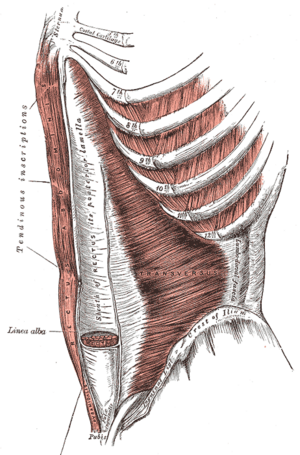Pyramidalis Muscle: Difference between revisions
No edit summary |
No edit summary |
||
| Line 5: | Line 5: | ||
</div> | </div> | ||
== Description == | == Description == | ||
Pyramidalis | [[File:Pyramidalis.png|right|frameless]] | ||
The paired pyramidalis muscles are small triangular-shaped muscles that lie between the anterior surface of the [[Rectus Abdominis|rectus abdominus]] and the posterior surface of the [[Rectus Sheath|rectus sheath]]. The precise function of pyramidalis muscles is unclear, but together the muscles are thought to tense the [[Linea Alba|linea alba.]] The muscles are not always present, or are often unilateral, and vary greatly in size.<ref>Lovering RM, Anderson LD. [https://www.ncbi.nlm.nih.gov/pmc/articles/PMC3531545/ Architecture and fiber type of the pyramidalis muscle]. Anatomical science international. 2008 Dec;83(4):294-7. Available: https://www.ncbi.nlm.nih.gov/pmc/articles/PMC3531545/<nowiki/>(accessed 20.12.20210</ref> | |||
=== Origin === | === Origin === | ||
Revision as of 01:46, 20 December 2021
Original Editor - Khloud Shreif
Top Contributors - Khloud Shreif, Lucinda hampton, Kim Jackson, Oyemi Sillo and Leana Louw
Description[edit | edit source]
The paired pyramidalis muscles are small triangular-shaped muscles that lie between the anterior surface of the rectus abdominus and the posterior surface of the rectus sheath. The precise function of pyramidalis muscles is unclear, but together the muscles are thought to tense the linea alba. The muscles are not always present, or are often unilateral, and vary greatly in size.[1]
Origin[edit | edit source]
It arises from symphysis pubic and pubic crest
Insertion[edit | edit source]
It decreases in size as it ascends and inserts medially to linea alba as a pointed apex.
Nerve[edit | edit source]
It is innervated by subcostal nerve T12
Artery[edit | edit source]
The main arterial supply from the inferior epigastric supply and the deep circumflex iliac artery to a lesser extent.
Function[edit | edit source]
When they contract tense the linea alba, contract with other abdominal muscle to increase positive abdominal pressure.[2]
Clinical relevance[edit | edit source]
It is used as a surgical landmark as in cesarean section to define the midline of the linea alba[4]. used as a source of muscle stem cell in the treatment of post-prostatectomy stress urinary incontinence[5]
Pyramidalis attached directly to the adductor longus via anterior pubic ligament forming Pyramidalis anterior pubic ligament Adductor Longus complex PLAC and that will help in the treatment of proximal adductor avulsion.[6]
References[edit | edit source]
- ↑ Lovering RM, Anderson LD. Architecture and fiber type of the pyramidalis muscle. Anatomical science international. 2008 Dec;83(4):294-7. Available: https://www.ncbi.nlm.nih.gov/pmc/articles/PMC3531545/(accessed 20.12.20210
- ↑ https://www.kenhub.com/en/library/anatomy/pyramidalis-muscle
- ↑ Kenhub - Learn Human Anatomy. Pyramidalis Muscle Overview and Function- Human Anatomy | Kenhub. Available from: http://www.youtube.com/watch?v=NR037gEOsWg[last accessed 17/5/2020]
- ↑ Das SS, Saluja S, Vasudeva N. Biometrics of Pyramidalis Muscle and its Clinical Importance. Journal of clinical and diagnostic research: JCDR. 2017 Feb;11(2):AC05.
- ↑ Sumino Y, Hirata Y, Hanada M, Akita Y, Sato F, Mimata H. Long‐term cryopreservation of pyramidalis muscle specimens as a source of striated muscle stem cells for treatment of post‐prostatectomy stress urinary incontinence. The Prostate. 2011 Aug 1;71(11):1225-30.
- ↑ Schilders E, Bharam S, Golan E, Dimitrakopoulou A, Mitchell A, Spaepen M, Beggs C, Cooke C, Holmich P. The pyramidalis–anterior pubic ligament–adductor longus complex (PLAC) and its role with adductor injuries: a new anatomical concept. Knee Surgery, Sports Traumatology, Arthroscopy. 2017 Dec 1;25(12):3969-77.







